|
1.
CENTRAL AND WEST AFRICA
Weather drives down production - balances with
weaker demand
Producers report demand remained quiet in early October
with production activity overshadowed by political events
and seasonal weather patterns. Elections dominate the
agenda in Gabon and Cameroon while Congo looks ahead
to its presidential elections scheduled for March 2026.
The rain season is now in full swing across the region. In
Gabon and Congo heavy rains are expected to continue
until December followed by a two-month dry period. In
Cameroon rains should persist until the end of December
before the onset of a six-month dry season.
Production continues to be affected by difficult weather
conditions resulting in slower harvesting and supply
disruptions but these are largely balanced by the currently
weak international demand keeping stock levels low.
Prices remain generally stable across key markets.
Tropical Timber Trade Facility support from Germany
In other regional news the Central African Forest
Commission (COMIFAC) recently signed a grant
agreement under the Tropical Timber Trade Facility
project with the German Federal Ministry for Economic
Cooperation and Development to be implemented by GIZ
in partnership with COMIFAC and its member States
(Cameroon, Central African Republic, Equatorial Guinea,
Gabon, Democratic Republic of the Congo and Republic
of the Congo).
The main objective is to reduce illegal deforestation in the
Congo Basin by promoting a legal and sustainable trade in
tropical timber and wood products.
The Tropical Timber Trade Facility (TTT) is a project of
the German Federal Ministry for Economic Cooperation
and Development (BMZ) and began in 2023. The project
tackles the illegal timber trade in the Congo Basin.
See: https://www.businessincameroon.com/economy/2309-
12764-comifac-cracks-down-on-illegal-wood-trafficking-in-
central-africa
Country round-up
Gabon
October has brought the expected onset of the rain season
across Gabon with daily rainfall in the interior regions and
persistent wet conditions throughout the country. The end
of the dry period has led to slower harvesting activities
and overall production remains low. International buyers
continue to hold off from placing significant new orders
contributing to subdued operational levels.
Transport is becoming increasingly affected as road repair
projects proceed on major routes such as the Okonja–
Makoukou–Lastourville–Ovang–Lopé–Ndjolé to Bifoun
route. Road works are critical for maintaining delivery
flows to Libreville but are currently causing delays.
Log Stocks
It has been reported that the GSEZ log park in the Nkok
Special Zone currently holds approximately 35,000 cu.m.,
mainly Okoume, alongside red species such as Bosse,
Sapelli, Padouk and a small volume of Azobé and Okan.
The focus remains on Okoume, with stocks estimated at
around 30,000 cu.m.
In China, Zhangjiagang Port is reported to have
approximately two years of log stock in reserve, double
the usual consumption cycle. This significant surplus is
suppressing import demand in China and putting further
pressure on Gabonese producers.
Transport and Logistics
A serious incident occurred at SETRAG’s log stock yard
in Lastourville. It is reported timber residues caught fire
and spread destroying part of the log stocks, mainly
Okoume. Negotiations over compensation are ongoing.
Container availability remains adequate with no reported
shortages. Port operations are generally stable though
dredging work took place over a five-day period this
month, temporarily preventing large container vessels
from berthing.
Additionally, a French naval vessel is scheduled to visit
Libreville for seven days at the end of the month, likely
causing further temporary port congestion.
Electricity and Milling Operations
Electricity disruptions continue to affect operations in
Libreville. There are currently two daily power cuts,
typically lasting two to three hours, including frequent
night-time outages.
Although the government has ordered SEEG to stabilise
the power distribution and is preparing to add a third
Turkish power ship to boost capacity to 228,000 kW, the
new ship is not yet connected due to delays in laying the 9
km cable. These interruptions, combined with
administrative delays, are constraining milling activities.
Market demand
The Chinese market remains extremely weak which has
resulted in some Chinese operated mills closing. Some
mills maintain limited regular shipments but overall
demand from China is very low.
The Philippines has also reduced its Okoume purchases. In
contrast, Viet Nam continues to display solid demand for
Tali and increasingly Padouk sawn timber.
The Middle East market is slowing with Okoume facing
strong price competition from Brazilian softwood which is
reportedly being sold at half the price of Okoume.
European demand remains low, characterised by short-
term, supply-on-demand orders. The Netherlands
continues to receive regular monthly Azobé volumes of
around 2,500–3,000 cu.m but there is no significant pick-
up elsewhere.
Several companies have not yet fully paid their land taxes
which were due at the end of March. Furthermore, the
social tax of 800 FCFA/cu.m., owed to local communities,
remains largely unpaid prompting the government to
initiate checks across the country. Presidential directives
have emphasised recovery of outstanding amounts.
All timber bundles must now be marked with GPS details
on four sides. A new weighbridge is set to become
operational at the end of October approximately 150 km
from Libreville with a maximum tonnage of 32 tonnes.
However, there are already concerns about inadequate
parking capacity for trucks near the site.
Demand sentiment
Overall sentiment remains subdued. The collapse of the
Okan market in China and the Netherlands, coupled with
large inventories and competition from Brazilian pine, is
exerting significant downward pressure on Gabonese
exports. Forestry authorities are simultaneously tightening
regulatory enforcement and tax collection, creating
additional compliance and cost burdens for operators.
Cameroon
Heavy rains have returned and are expected to persist until
the end of December. Conditions are wet nationwide and
both harvesting and forest‐to-mill transport have slowed.
Worker availability is said to be adequate, including
technicians, so the primary constraint remains access
rather than labour.
Sawmills are operating but at reduced throughput. New
contracts are slow to arrive and several operators are
deliberately limiting commitments until the political
calendar clears.
No shortage of containers has been mentioned. The
principal logistical challenges stem from weather-related
slowdowns rather than equipment or spares which are not
flagged as an acute issue at this time.
Enquiry levels are subdued. Operators are maintaining
essential production but deferring investment and
expansion decisions. Overall market tone is cautious with
buyers slow to confirm orders and suppliers prioritising
continuity over growth.
Steep log taxes driving shift to processing
Cameroon’s fiscal regime has undergone a major
transformation. Between 2017 and 2024 the export duty on
logs rose from 17.5% to 75% of the FOB value. This
steep tax hike has significantly reduced log exports which
represented just 1% of total wood export earnings in the
first quarter of 2025.
Exporters are increasingly shifting to processing as duties
on sawnwood, although rising (165% between 2016 and
2023), remain less prohibitive. To support this strategy the
government has implemented customs duty exemptions on
wood-processing equipment, encouraging value-added
transformation over raw log exports.
This policy is reshaping Cameroon’s timber sector
structure and is expected to deepen the focus on sawn
wood and other processed products in the coming years.
See: https://www.businessincameroon.com/public-
management/0210-15127-steep-log-taxes-drive-cameroon-s-
timber-sector-toward-processed-wood
Regulatory and compliance environment
Preparations for the EUDR are intensifying. European
importers have been dispatching auditors to suppliers with
specific due-diligence instructions in preparation for the
tougher import rules.
While there is discussion of a potential 12-month delay in
EUDR enforcement operators remain on alert, particularly
given Cameroon’s exposure in commodities developed on
formerly forested land (notably palm oil and bananas in
areas such as Edéa to Kribi and in West Cameroon, Tiko
and Buea).
Assuming a calm post-election period and continued
container availability activity could stabilise modestly into
November, though any recovery will depend on weather
conditions and buyer confidence.
Republic of Congo
The rain season has advanced from north to south but
harvesting activities remain at a normal level, albeit
reduced compared to earlier in the year due to weaker
demand from Asia and Europe.
The main species harvested include Sapelli, Ayous, Iroko,
Padouk and Azobe. Reduced Chinese orders are forcing
mills to pivot toward European markets which carry the
risk of overproduction, particularly for Padouk. Demand
from the Philippines for Okoume has slowed while Viet
Nam remains active for Tali and Padouk. Middle Eastern
demand for Okoume sawnwood is also low.
Transport and logistics
Transport challenges persist, particularly for operators in
the northern regions and the Central African Republic who
rely on difficult road networks to reach Douala Port.
The Likouala region has seen some improvement in
transport conditions though heavy rains continue to
complicate logistics. Increasing volumes are being
diverted toward Kribi Port in Cameroon for export.
Regulatory environment
The government is maintaining a stable policy
environment but is pressuring companies toward third-
level transformations (veneer and plywood) to stimulate
domestic value addition.
Operators continue to pay land taxes (Assiette de Coupe)
on their active concession areas. No major fiscal measures
have been announced since the Bassin Congo meeting for
which no further official information has been released.
However, the government is monitoring company finances
more closely, especially for tax and duty arrears.
The Republic of the Congo remains more export-oriented
than its neighbour, the DRC. Timber accounts for roughly
3% of national exports compared to oil at 89%.
Historically, China has absorbed over 90% of Congolese
wood exports, primarily in raw log form. While export
quotas technically limit logs to 15% of annual production
for selected species. With limited processing capacity the
emphasis remains on logs.
In the Democratic Republic of the Congo it has been
reported that governance, widespread artisanal logging and
rebel group control over key forested areas continue to
destabilise regional timber markets. Illegal extraction is
said to be accelerating in areas such as Kahuzi-Biega
National Park.
Market demand and outlook
Demand in Asia, particularly China, remains muted
creating downward pressure on harvest volumes. European
demand for certified products continues but is highly
selective and compliance with CITES and EUTR/EUDR
regulations is tightening. The third transformation push by
the government, combined with lower log demand, is
likely to nudge operators gradually toward more
processing, though infrastructure constraints remain
significant.
Dependency on the Chinese market continues to be a
strategic vulnerability exposing Congo to external shocks
in demand and regulation. International scrutiny of Congo
Basin logging is expected to intensify into late 2025 and
2026 increasing compliance costs and pressure for better
governance.
The Congolese timber sector in mid-October 2025 is
weathering seasonal rains with steady operations but under
softer market demand. Government pressure for increased
processing is mounting while Chinese market weakness
and logistical challenges continue to shape export
strategies. The sector remains stable but exposed, with
medium-term prospects hinging on infrastructure
improvements, policy clarity and diversification of export
destinations.
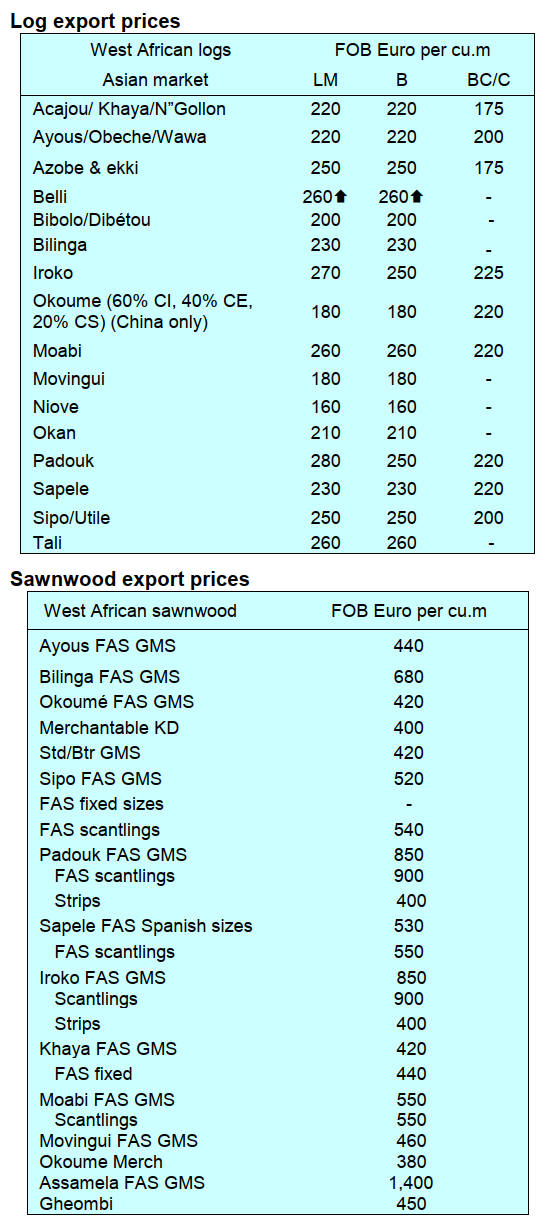
2.
GHANA
Forestry Commission appoints Acting Deputy Chief
Executive
The Forestry Commission has engaged the services of Mr.
Timothy Ataboadey Awotiiri as Acting Deputy Chief
Executive to the Commission.At a brief meeting at the
Commission’s Head Office the Chief Executive of
Forestry Commission Dr. Hugh C.A Brown and members
of the executive management team welcomed Mr.
Timothy Awotiiri. Mr. Awotiiri, was a former member of
parliament for Builsa North.
See: https://fcghana.org/ag-ce-welcomes-new-ag-deputy-ce/
IMF fifth staff-level agreement
Ghana and the International Monetary Fund (IMF) have
reached a staff-level agreement on the fifth review of the
country’s economic programme under the Extended Credit
Facility (ECF) arrangement. This staff-level agreement is
subject to IMF Management’s review and approval
process executed by its Executive Board. After
consideration by the Executive Board, Ghana would have
access to additional US$385 million bringing the total
IMF financial support to about US$ 2.8 billion.
The team’s engagement established that Ghana’s
macroeconomic stabilisation is taking root with growth in
2025 the first half stronger than anticipated. The external
sector has also improved noticeably with the country’s
exports which include wood products.
The positive momentum is expected to continue into 2026
with growth projected at 4.8%. Inflation is forecasted to
remain within the Bank of Ghana’s (BoG) target band of
8±2 percent, allowing for gradual monetary policy
normalisation.
See: https://thebftonline.com/2025/10/10/imf-reaches-staff-level-
agreement-on-fifth-review-of-extended-credit-facility-with-
ghana/
and
https://www.imf.org/en/News/Articles/2025/10/09/pr-25338-
ghana-imf-reaches-agreement-on-the-5th-review-of-the-ecf
Export receipts fall 19% year-on-year
Ghana’s wood product export earnings in the first eight
months of 2025 fell 19% year-on-year according to the
Timber Industry Development Division (TIDD) August
2025 report.
The report revealed that a total of Eur66.44 million was
earned from the export of 143,438 cu.m for the period
under review compared with Eur82.46 million recorded in
the same period of 2024 from 182,542 cu.m. The drop in
exports could be attributed to the dwindling supply of raw
materials faced by local millers as well as macro-
economic constraints.
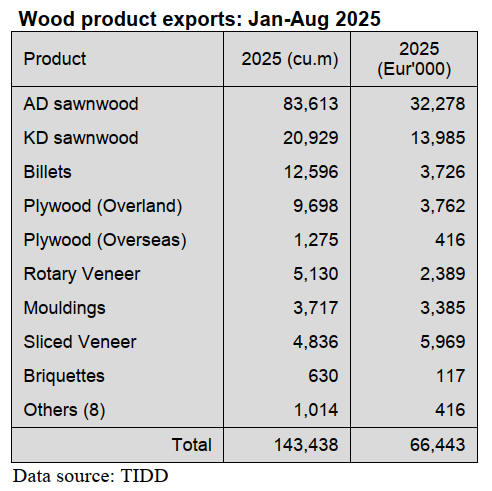
With a total of 17 products exported during the period,
primary product exports which included air-dried
sawnwood, billets, air-dried boules and poles earned
Eur36.28 million from 97,050 cu.m of the total export
value and volume respectively.
Tertiary wood products accounted for 5% of export
volumes while exports of secondary wood products
accounted for the balance. Concerns have been raised that
further progress in production of added value products is
hindered by outdated machinery and low-level production
techniques.
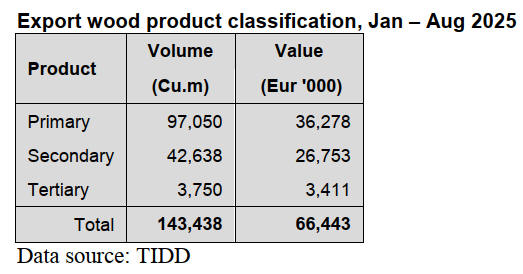
The Asian and European markets remain the stronghold
for Ghana’s wood product exports accounting for an
average of 66% and 16% respectively of the total export
volumes.
In August 2025 India was the single largest importer of
Ghana’s wood products, accounting for 50% of the total
export volume. India imported 7,408 cu.m of air-dried teak
sawnwood valued at Eur2.59 million. Teak products,
especially air-dried sawnwood, was the main species
exported. Italy and Spain imported sliced veneer but there
was a decline in rotary veneer exports to the US.
Bank of Ghana cuts policy rate
At its Monetary Policy Committee meeting the Bank of
Ghana lowered the policy rate by 350 basis points to
21.5%, the lowest level since 2019. This has signaled
confidence to the business community that the country’s
inflationary pressures will continue to ease while
economic growth remains robust.
The Bank has reinforced its determination to sustain the
disinflation process that has brought headline inflation to
its lowest level in four years. In July the Bank announced
a rate cut by 300 points that already brought reduced
borrowing costs in the money market and helped banks to
pass on lower rates to businesses and households.
According to the Ghana Statistical Service, Ghana's year
on year Inflation for September dropped significantly to
9.4% from 11.5% in August 2025. This is the lowest since
August 2021 and the ninth consecutive decline.
High cost of electricity taking a toll on businesses
The high cost of electricity is placing a heavy burden on
businesses and Ghanaians at large. Business associations
have urged the government to implement urgent reforms at
the Electricity Company of Ghana while some tax analysts
are proposing broader stakeholder engagement to reform
the ECG and boost its operational efficiency.
See: https://www.myjoyonline.com/bogs-historic-big-cut-faces-
tariffs-external-shocks-and-bank-risks/
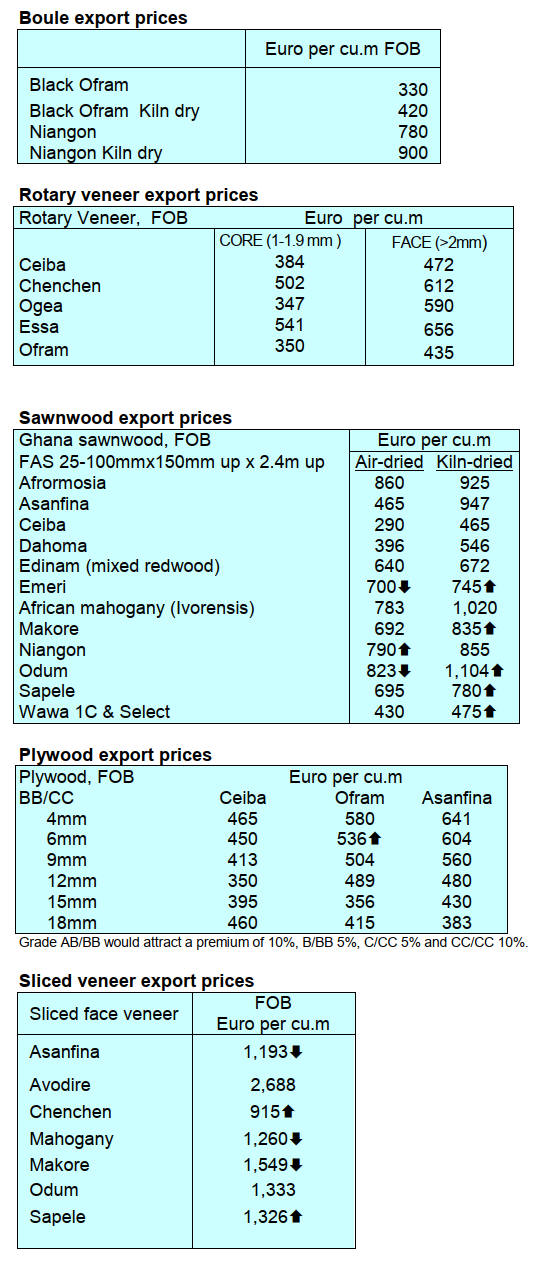
3. MALAYSIA
Half of Malaysia’s furniture exports go to the US
In 2024 Malaysia exported RM9.89 bil worth of furniture
which represented 43% of all wood product exports. This
year, between January and July, RM5.46 bil. of furniture
was exported out of a total of RM12.64 bil wood product
exports.
With more than half of Malaysia’s furniture exports going
to the US the 25% tariffs on imported kitchen cabinets,
bathroom vanities and upholstered furniture is likely to hit
the industry hard. The local furniture industry is now
looking to the government to provide support.
Malaysian Furniture Council (MFC) CEO, Desmond Tan,
said implementing measures such as short-term financing,
tax relief, equipment upgrades and export market
incentives could help manufacturers navigate these
challenge.
According to the Malaysian Timber Council wooden
furniture exports to the US reached RM5.71bil last year,
accounting for 58% of Malaysia’s total wooden furniture
exports. US orders typically consist of bedroom furniture,
dining sets and upholstered items.
Philip Fong, a Director at Mi Kuang Furniture Centre in
Johor, said that if raw material costs were to rise due to
global factors local furniture prices could also go up.
However, he said, there could be a silver lining in the US
stance “If exporters see reduced orders from the US some
of their production capacity may be redirected to the
domestic market” .
Muar Furniture Association (MFA) president, Steve Ong,
said that, while the US stance may unsettle the market
initially, orders from the US will continue as American
consumers still rely on imports to meet their needs.
Investment, Trade and Industry Minister, Zafrul Abdul
Aziz, has said that Malaysia was actively engaging with
the US on tariff-related issues, particularly tariffs on
furniture products. Malaysia and the US are expected to
sign the Reciprocal Trade Agreement during Malaysia’s
chairmanship of the upcoming 47th ASEAN Summit
which takes place in Kuala Lumpur from 26-28 October.
Recently, the Deputy-Secretary General of the Ministry of
Investment, Trade and Industry, Mastura Ahmad Mustafa,
who also serves as the chief negotiator on US tariffs,
stated that the ministry is actively engaging with the US to
seek tariff exemptions for various products including
furniture.
“We remain hopeful for a positive outcome but we are not
sure of this,” said Desmond Tan, president of the
Malaysian Furniture Council. Tan added that both
countries share a mutually dependent economic
relationship.
The tariffs come at a time when the US economy is
showing signs of slowing and the US dollar weakening, all
of which is a negative for Malaysian furniture exporters.
Tan urged the government to provide support to the
furniture industry which has been severely affected by
these tariffs.
See: https://www.thestar.com.my/business/business-
news/2025/10/01/hoping-for-tariff-relief
Growth becoming more dependant on domestic
private consumption
According to the World Bank Malaysia’s economic
growth is expected to remain at 4.1% in 2026, unchanged
from its 2025 forecast. Its Lead Economist for Malaysia,
Dr. Apurva Sanghi, said the growth momentum is slowing
and 2026 would be rather restrained as external and
domestic factors are likely to cap growth. “Global and
regional forecasts are not that rosy. Specifically, we find
Malaysia’s economy highly sensitive to changes in the US
and China,” he said.
Apurva said Malaysia’s economic growth would mainly
be driven by private consumption, buoyed by wage
increases, government transfers and accommodative
monetary policy. In terms of the sensitivity changes of the
US and China, he explained that a 1% point reduction in
US growth reduces estimated growth in Malaysia by 0.8
percentage points. Additionally, a one percentage point
decline in growth in China reduces growth in Malaysia by
about 0.45 percentage points. “The next phase of
Malaysia’s economic story hinges on productivity,
innovation and deeper integration,” said Apurva.
See:
http://theborneopost.pressreader.com/article/282239491821434
40 years of Forest Research
Four decades since its establishment, the Forest Research
Institute of Malaysia (FRIM) is poised to elevate its
national contributions through high-impact research, green
innovation and biodiversity conservation research.
FRIM Director-General, Datuk Dr. Ismail Parlan, is
confident that with the continued support from all parties
the institute will remain relevant and authoritative as the
leading research institution for the well-being of the
people and future generations. “FRIM will continue to
play a key role in the fields of tropical forestry research,
biodiversity, climate change, biotechnology, forest
products and development based on natural resources,” he
was reported as saying.
See:
https://www.thestar.com.my/news/nation/2025/10/06/research-
and-passion-the-root-of-frims-success
4.
INDONESIA
Export Benchmark Price (HPE) for
wood products
October 2025
The following is a list of Wood HPE from 1-31 October
2025.
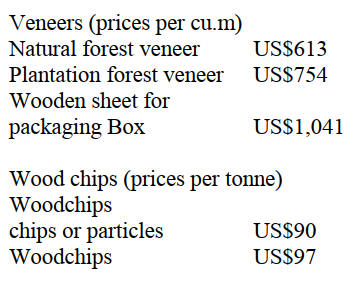
Processed wood (prices per cu.m)
Processed wood products which are leveled on all four
sides so that the surface becomes even and smooth with
the provisions of a cross-sectional area of 1,000 sq.mm to
4,000 sq.mm (ex 4407.11.00 to ex 4407.99.90)
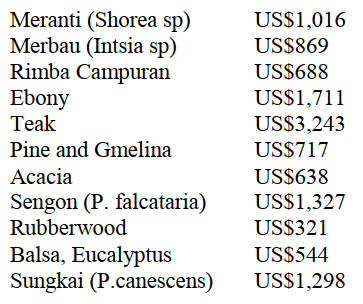
Processed wood products which are levelled on all four
sides so that the surface becomes even and smooth of
Merbau wood with the provisions of a cross-sectional area
of 4,000 sq.mm to 10,000 sq.mm (ex 4407.11.00 to ex
4407.99.90) = US$1,500/cu.m
See: https://jdih.kemendag.go.id/peraturan/keputusan-menteri-
perdagangan-republik-indonesia-nomor-1990-tahun-2025-
tentang-harga-patokan-ekspor-dan-harga-referensi-atas-produk-
pertanian-dan-kehutanan-yang-dikenakan-bea-keluar
Plywood exports recorded growth in the first half of
year
The Indonesia Eximbank (LPEI), through its Indonesia
Exim Bank Institute, projects positive growth for
Indonesia's plywood exports in 2025 and 2026 despite
global economic uncertainties and challenges in raw
material supply.
According to Rini Satriani, Chief Specialist of Market
Intelligence and Leads Management, the value of plywood
exports is expected to grow by 8% year-on-year in 2025
driven by steady demand from key markets like the US,
China and Malaysia.
This upward trend is forecast to continue into 2026 with
an estimated 4% growth. Demand in the US is particularly
significant due to the expanding recreational vehicle (RV)
industry which relies heavily on plywood for interiors.
In the first half of 2025 Indonesia’s plywood exports
recorded positive growth with an almost 4% rise in value
and a 3% increase in volume compared to the previous
period.
Indonesia remains a strong global competitor in plywood
exports ranking second worldwide and exporting to over
85 countries with the support of more than 400 active
exporters.
Its competitive pricing, abundant timber resources and the
internationally recognised SVLK certification contribute
to its market strength. However, the industry faces
growing competition from emerging exporters and the
limited supply of certified wood due to high compliance
costs. To sustain long-term growth Rini highlighted the
need for improved access to wood certification, cost
efficiency in production and expanded market reach
through international trade agreements.
See: https://koran-jakarta.com/2025-10-05/ekspor-kayu-lapis-
diprediksi-moncer-lpei-sebut-momentum-20252026-jadi-titik-
kuat-industri-kehutanan?page=1
and
https://www.merdeka.com/uang/indonesia-eksportir-kayu-lapis-
terbesar-kedua-dunia-proyeksi-lpei-ekspor-plywood-tumbuh-
positif-hingga-2026-477134-mvk.html?page=4
US tariffs to heavily impact Indonesian furniture
exporters
The recent announcement by the US to impose higher
tariffs on imported furniture, 50% on kitchen cabinets and
bathroom vanities, and 30% on upholstered products has
raised concerns in Indonesia. The new policy, effective 1
October 2025, is expected to heavily impact Indonesian
furniture exporters who rely significantly on the US
market.
Economist Wijayanto Samirin from Paramadina
University has urged the Indonesian government to swiftly
engage in negotiations with the US to seek exemptions for
key export commodities, including furniture.
He points out that while some countries are already in
talks for exclusions, Indonesia must advocate strongly for
its core industries such as textiles, footwear, palm oil and
furniture to be protected from the new tariffs. Without
such measures, Indonesia's furniture sector could suffer
long-term setbacks in one of its most crucial export
markets.
Beginning 14 October 2025 the US will enforce a 25%
tariff on kitchen cabinets, bathroom vanities and
upholstered furniture under Section 232 of the US Trade
Act.
These tariffs are set to increase in 2026 with rates
potentially reaching 30% for upholstered products and
50% for certain items from countries that fail to strike
trade deals with the US.
Indonesian exporters are already feeling the impact, with
US buyers delaying or renegotiating upholstery orders and
becoming more cautious overall. While there was a short-
term surge in shipments to beat tariff deadlines, future
orders are expected to decline, especially in the upholstery
segment.
The combined effect of the new and existing tariffs could
lead to a total duty of 29% on lumber and 44% on
upholstered furniture from Indonesia. This is projected to
cause a 20–35% drop in upholstered furniture orders over
the next three to six months, particularly impacting OEM
manufacturers working with tight margins.
Wood case goods are also at risk with expected order
declines of 10–15% due to higher costs and a possible
shift by US buyers to alternative suppliers.
See: https://finance.detik.com/berita-ekonomi-bisnis/d-
8134725/ekspor-furnitur-ri-terancam-merosot-imbas-tarif-trump.
and
https://www.thejakartapost.com/business/2025/10/05/furniture-
makers-expect-decline-in-orders-under-new-us-tariffs.html.
In related news, the Indonesian furniture and handicraft
industry is facing severe challenges due to a combination
of the rupiah’s depreciation and new US tariffs. While the
weakened rupiah boosts export revenue in local currency
most input costs are dollar-based leading to higher
production expenses.
The crisis deepened when the United States, Indonesia’s
main export market, imposed steep tariffs on kitchen
cabinets and vanities and 30% on upholstered furniture.
This is especially damaging given that the US accounts for
over half of Indonesia’s furniture exports. Industry data
shows Indonesia already trails far behind global
competitors like Viet Nam and China in market share,
making the new trade barriers even more critical.
Abdul Sobur, Chairman of HIMKI, has called for urgent
and strategic government intervention. To stabilise the
industry HIMKI is pushing for financial relief, including
tax allowance or tax holidays for two to three years and
increased export loan interest subsidies. Without such
support the industry risks further decline amid intensifying
global competition and restricted access to its largest
export destination say HIMKI.
See:
https://money.kompas.com/read/2025/10/01/162221626/industri-
mebel-dihantam-pelemahan-rupiah-dan-tarif-impor?
and
https://kumparan.com/kumparanbisnis/industri-mebel-tertekan-
rupiah-tarif-trump-minta-tambah-insentif-pajak-25xfYTK6AgD
and
https://www.kompas.id/artikel/surplus-perdagangan-terjaga-
ekspor-furnitur-hadapi-tekanan-tarif-as?loc=hard_paywall
A challenge for industry: scarcity of high-quality raw
materials
Indonesia's wood industry is currently grappling with
significant challenges primarily due to the scarcity of
high-quality raw materials and rising global demand for
eco-friendly products. According to the Indonesian
Sawmill and Woodworking Association (ISWA), the
future of the sector depends heavily on technological
innovations that enhance product lifespan, durability and
environmental sustainability.
These innovations are not limited to furniture or
woodworking but extend to architecture, construction and
property development, underlining the need for cross-
sector collaboration.
ISWA leaders argue that innovative treatments such as
eco-friendly chemicals and high-temperature processes
can significantly improve the quality of fast-growing or
plantation wood making it more stable and less prone to
manufacturing defects. This not only adds value for
farmers and the industry but also helps extend the wood’s
lifespan from a few years to decades. Ultimately,
innovation in the wood industry is being positioned not
just as a business solution but as a broader environmental
and social strategy for sustainable development.
See: https://www.antaranews.com/berita/5137917/iswa-dorong-
inovasi-kayu-rekayasa-pacu-kontribusi-industri-pengolahan
Indonesia - global hub in furniture innovation
Indonesia is aiming to become a global hub for furniture
innovation driven by steady growth in its furniture,
handicraft and interior design sectors. According to the
Ministry of Creative Economy, these industries play a
significant role in job creation and export performance.
In 2025 furniture exports accounted for approximately
12% of the handicraft subsector ranking second and
surpassing other categories such as musical instruments
and children's toys.
At the IFMAC and WoodMac 2025 exhibition in Jakarta,
Deputy Minister Yuke Sri Rahayu highlighted the
importance of international collaboration particularly in
wood processing and hardware to boost the country’s
position in the global market.
To support this goal, the government is promoting a
hexahelix model of collaboration, engaging stakeholders
from government, business, academia, communities,
media and investors.
See: https://investor.id/business/411003/indonesia-sebagai-pusat-
industri-furnitur-dan-woodworking
Indonesia welcomes the Tropical Forest Financing
Facility initiative
Indonesia has expressed strong support for the
establishment of the Tropical Forest Financing Facility
(TFFF), with Coordinating Minister for Food Affairs,
Zulkifli Hasan, reaffirming the nation's commitment to
preserving tropical forests.
Minister Hasan highlighted that the responsibility for
protecting these forests is not only for the countries that
host them but is a global moral obligation. He noted that
one of the key challenges to forest conservation is the lack
of sufficient and stable funding which is why the TFFF
initiative is seen as a crucial step to fill the financial gaps
in conservation efforts, ecosystem restoration, and the
empowerment of local and indigenous communities.
See: https://www.msn.com/id-id/ekonomi/ekonomi/indonesia-
menyambut-baik-pembentukan-tropical-forest-financing-
facility/ar-AA1NfLew?ocid=BingNewsVerp
Strengthening social forestry to drive green economy
Indonesia is strengthening its social forestry, natural
resource conservation and forestry development
programmes to accelerate the transition toward a green
economy.
Deputy Minister of Forestry, Rohmat Marzuki,
emphasised that social forestry is a key national strategy to
create jobs, enhance welfare and preserve forests. The
programme has around 8.3 million hectares benefiting
over 1.4 million households nationwide. In Maluku
province, 171 social forestry permits have been issued,
covering 240,000 hectares and involving over 33,000
households.
These efforts have led to the creation of 533 Social
Forestry Business Groups (KUPS) which have generated
approximately Rp3.85 billion in economic transactions
this year.
Additionally, Maluku has launched its first exports of non-
timber forest products, sending 30 tonnes of damar resin
worth Rp570 million to India and 15 tonnes of nutmeg
worth Rp1.5 billion to China. Marzuki highlighted that
these developments demonstrate the potential for
economic, ecological and social benefits to align in
support of Indonesia's green economy goals.
See: https://en.antaranews.com/news/382244/indonesia-
strengthens-social-forestry-to-drive-green-economy
Human resources development in forestry sector
The Indonesian Ministry of Forestry, through its Agency
for Forestry Extension and Human Resources
Development (BP2SDM) is strengthening the
development of human resources in the forestry sector to
create a more advanced and adaptive workforce.
BP2SDM has launched a strategic transformation initiative
built around four key pillars aimed at enhancing
effectiveness, adaptability and impact. These include
improving internal and external communication strategies,
promoting a work culture focused on collaboration and
innovation, fostering regional creativity through the "One
Regional Office, One Innovation" programme and
implementing a Corporate University model to establish a
continuous learning ecosystem.
The Head of BP2SDM, Indra Eksploitasia, emphasised
that the agency must become the driving force behind
forestry development aligned with the vision of "Forestry
Human Excellence." The transformation efforts involve
cross-agency collaboration with regional offices, forestry
centres and educational institutions.
Indra called on pillar leaders and team members to carry
out their responsibilities with commitment, ensuring that
the outcomes of the initiative are practical and have a
tangible impact, particularly at the field level.
See: https://en.antaranews.com/news/382108/ministry-
strengthens-human-resources-development-in-forestry-sector
APHI - Strengthen integrity of Indonesia’s carbon
market
The Association of Indonesian Forest Concession Holders
(APHI) has expressed its full support for the government’s
efforts to enhance the integrity and credibility of
Indonesia's carbon market.
APHI Chairman, Soewarso, emphasised that this initiative
is a key opportunity to integrate environmental policies,
green investments and sustainable forest governance into a
fair and measurable framework.
He highlighted the critical role of the forestry sector in
carbon emission absorption, particularly through industrial
plantations, ecosystem restoration and land rehabilitation,
asserting that forest entrepreneurs must be seen as active
contributors to climate solutions, not just wood suppliers.
Soewarso further stressed the importance of collaboration
among various stakeholders, including the government,
businesses, international organisations and local
communities, to ensure the effectiveness and credibility of
carbon trading. This collaboration would help strengthen
verification systems, enhance technical capacity and
ensure that carbon trading benefits local communities. He
also emphasised the need to align carbon trading policies
with landuse and licensing regulations to ensure a
cohesive and sustainable system.
See: https://koran-jakarta.com/2025-10-07/aphi-dorong-
penguatan-integritas-pasar-karbon-indonesia
3.7 million hectares of peatland restored
Indonesia has successfully restored 3.7 million hectares of
peatland within concession areas, along with 52,000
hectares on community lands through the Independent
Peatland Care Villages (DMPG) programme. Agus
Justianto, Senior Policy Analyst at the Ministry of Forestry
presented these achievements during the Peatland
Breakthrough forum at the UN in New York, part of the
New York Climate Week.
He highlighted that Indonesia holds the world’s largest
tropical peatland, covering 24.67 million hectares, with a
carbon reserve of approximately 46 gigatons, which
constitutes 8–14% of the global peat carbon stock.
Additionally, Indonesia launched the International
Tropical Peatlands Center (ITPC) to foster scientific
collaboration and share best practices with countries in
Southeast Asia, the Congo and Peru.
In related news, Indonesia's Environment Minister has
called on companies to increase their support for peatland
restoration efforts, particularly by empowering local
communities near concession areas.
Speaking at the Peat Ecosystem Restoration Collaboration
Forum, Hanif Faisol Nurofiq emphasised the
government’s goal of managing 2,354 Peat-Caring
Independent Villages with 1,450 of these villages
requiring direct assistance from businesses due to their
location in concession buffer zones. He urged businesses
to help provide training to local workers to equip them
with the skills necessary for effective peatland restoration.
See: https://forestinsights.id/indonesia-pulihkan-37-juta-hektare-
lahan-gambut/
and
https://forestinsights.id/klh-gandeng-stakeholders-untuk-
restorasi-ekosistem-gambut-dan-mangrove/
CEPA with Canada and EU strengthens trade
opportunities
Trade Minister Budi Santoso announced that the signing
of the Comprehensive Economic Partnership Agreements
(CEPA) with Canada and the European Union marked the
beginning of efforts to strengthen Indonesia's position in
global trade.
He emphasised that these agreements, namely the ICA-
CEPA with Canada and IEU-CEPA with the European
Union are crucial for boosting Indonesian exports amid the
current global trade and geopolitical challenges. In 2024,
Indonesia’s exports to Canada were valued at US$3.5
billion, while exports to the EU stood at US$30 billion,
and both agreements are expected to further increase these
figures.
The ICA-CEPA, signed in Ottawa in September provides
preferential treatment for over 90% of Indonesian tariff
lines, potentially boosting the competitiveness of products
like textiles, footwear, furniture and electronics in Canada.
Similarly, the IEU-CEPA, signed in September focuses on
reducing tariffs on over 98% of goods traded between
Indonesia and the EU. This agreement aims to increase
Indonesian exports to the EU by 2.5 times within the next
five years with a focus on labour-intensive sectors such as
palm oil, coffee, textiles and furniture.
See: https://en.antaranews.com/news/383129/cepa-with-canada-
eu-strengthens-indonesias-global-trade-minister
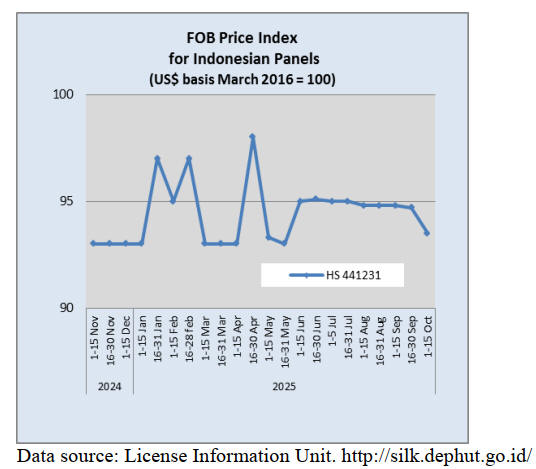
5.
MYANMAR
Conflict, Crackdowns and Shifting Trade
Myanmar's forestry and timber trade in 2025 remains a
complex issue marked by ongoing efforts to curb illegal
logging, a slight decrease in the overall deforestation rate
and limited international market access due to
sanctions. Recent months have seen a wave of illegal
timber seizures and a renewed governmental push towards
forest conservation. The sector continues to be a source of
revenue and at the same time a focal point of conflict.
Recent reports indicate that authorities are actively
cracking down on the illicit timber trade. These seizures
are part of a broader government initiative to intensify its
campaign against illegal trade in various sectors, including
forestry. Despite these efforts, political and social
instability in many parts of the country continues to fuel
unregulated logging activities.
The ongoing conflict creates a challenging environment
for effective forest governance and enforcement with
reports suggesting that both state-affiliated actors and non-
state groups are involved in the illicit timber trade.
In a move to bolster forest protection, the government
announced in August 2025 the establishment of numerous
reserved and protected forests, now covering nearly 26%
of the country's land area. This initiative, based on the
2018 Forest Law, aims to mitigate climate change,
conserve biodiversity and ensure the sustainable extraction
of forest products. Furthermore, the Chairman of the State
Administration Council has issued a directive to increase
the nation's forest coverage to 50%, signaling a high-level
commitment to reforestation and conservation.
The international timber trade from Myanmar remains
heavily shaped by sanctions. However, the trade has not
ceased instead, it has largely redirected towards Asian
markets. Also, Myanmar's timber finds its way to various
international markets, often through complex and opaque
supply chains.
The international market has been significantly altered by
sanctions but the trade continues through alternative
channels, highlighting the persistent global demand for
Myanmar's valuable timber resources.
See: https://sacoffice.gov.mm/en/senior-general-min-aung-
hlaing-state-security-and-peace-commission-chairman-republic-
union-0?utm_source=chatgpt.com,
and
https://news.mongabay.com/2025/10/protected-areas-hit-hard-as-
mekong-countries-forest-cover-shrank-in-
2024/?utm_source=chatgpt.com
and
https://www.globalforestwatch.org/dashboards/country/MMR/?ut
m_source=chatgpt.com
Jobs - strong hiring in banking and trading
Myanmar’s job market continues to show resilience and
diversification, with the banking and trading
sectors leading employment demand according to the
latest “Navigating Talent Trends in Myanmar” report
released by JobNet.com.mm for September 2025.
The banking, insurance and microfinance industry retained
its top position for job postings, signaling continued
expansion in financial services and credit access across the
country. It was followed by Fast-Moving Consumer
Goods (FMCG) and trading/distribution and import-export
underscoring steady consumer demand and cross-border
trade activities despite economic challenges.
JobNet’s report serves as a benchmark for professionals,
employers and jobseekers navigating Myanmar’s shifting
labour landscape. The company noted that the steady
demand in finance, trade and IT-related fields points to a
gradual digital and economic reorientation in Myanmar’s
post-pandemic workforce.
See: https://banking.einnews.com/pr_news/856315844/2025-
september-navigating-talent-trends-in-myanmar
Central Bank tightens monetary policy
The Central Bank of Myanmar (CBM) has announced new
measures to absorb excess liquidity in the financial system
in an effort to curb inflation and stabilise the kyat.
According to the CBM’s statement, banks will be required
to increase their Average Excess Reserve funds held
beyond the mandatory 28-day reserve in kyat at the
Central Bank.
The Central Bank said the policy aims to restrain
inflation, support the kyat’s value and enhance interest
income for banks which could strengthen both banking
sector stability and overall monetary stability in Myanmar.
See: https://burmese.dvb.no/post/727300
6.
INDIA
India’s growing economic resilience
Speaking at the Kautilya Economic Conclave, the Minister
of Finance, Nirmala Sitharaman, highlighted India’s
growing economic resilience and said that the nation is
well-equipped to absorb external shocks amid ongoing
external trade tensions.
“Our capacity to absorb shocks is strong, while our
economic leverage is evolving. Our choices will determine
whether resilience becomes a foundation for leadership or
merely a buffer against uncertainty. So in conclusion,
history teaches us that crises often precede renewal”, said
Sitharaman
She added “Geopolitical conflicts are intensifying.
Sanctions, tariffs and decoupling strategies are reshaping
global supply chains and that these dynamics highlight
both India’s vulnerability and resilience
Becoming ‘Viksit Bharat’ (more economically
independent) by 2047 does not imply that India wants to
be a closed economy the Minister said adding, “we have to
reach 8% GDP growth to get to the goal for a developed
nation.”
See: https://timesofindia.indiatimes.com/business/india-
business/indian-economy-resilient-can-absorb-shocks-fm-
sitharaman-says-amid-50-us-tariffs-targets-8-gdp-
growth/articleshow/124283495.cms
Households beginning to feel relief from rising prices
According to the Reserve Bank of India’s latest Inflation
Expectations Survey, Indian households are beginning to
feel some relief from rising prices. The September 2025
survey showed that while households’ perception of
current inflation rose slightly, expected price increases
across major product categories including food, non-food
items, housing and services, have eased, signalling a
possible slowdown in the country’s cost-of-living
pressures.
Conducted between 28 August and 6 September across 19
major cities the survey found that median current inflation
perception rose marginally by 20 basis points to 7.4%
compared with the previous round. However, households
expect prices to rise less in the near future. Three-month
inflation expectations dropped to 8.1%, down 20 basis
points, while one-year expectations fell.
See: https://timesofindia.indiatimes.com/business/india-
business/inflation-outlook-indian-households-expect-price-
pressure-to-cool-heres-what-rbi-survey-
says/articleshow/124282015.cms
An assessment of India’s office market
In a press release the Confederation of Real Estate
Developers' Associations of India (CREDAI) reports that,
in collaboration with real estate data intelligence company,
CRE Matrix, an assessment of India’s Office Market has
been prepared revealing sustained momentum across
India’s commercial real estate landscape.
The report highlights the market’s structural strength with
vacancy rates declining between 2024 and 2025
underpinned by robust demand of 34.5 million square feet
in the first half of 2025 and consistent absorption across
major business hubs.
The Indian office market’s resilience is anchored by a
balanced demand-supply ratio of 1.3 times over the last six
quarters reflecting the continued confidence of occupiers
and the expansion of Global Capability Centres (GCCs).
The ongoing shift towards flexible work models and
strong domestic demand are also driving robust absorption
rates across Bengaluru, Mumbai Metropolitan Region,
Delhi and Hyderabad.
See: https://credai.org/media/view-details/?file_no=94
Changes to tax - wood based panel sector has not
benefitted
Recently Central government announced the GST (Goods
& Services Tax) reforms which eliminated the 28% and
12% tax on multiple consumer goods, however, the wood
based panel sector has not benefitted from the recent
changes despite a flurry of letters from various industry
associations seeking to bring the GST on agro-forestry
sourced plywood product from the current 18% to 5%.
Following the recent GST revisions the tax rates on
bagasse based particleboard and cement bonded
particleboard have been brought down from 12% to 5%
whereas the rate on craft paper and print base paper used
in high preasure laminate manufacturing has been
increased from 12% to 18%.
Plywood associations across the country such as the
Federation of Indian Plywood and Panel Industry, the
Haryana Plywood Manufacturers Association, the Punjab
Plywood Manufacturers Association, theUP-PWMA Utter
Pradesh Plywood Manufacturers Association, the All
Bharat Plywood & Laminate Trade Association and many
others have requested the finance ministry to reduce the
18% rate on agro-forestry based plywood products.
The plea had been made in the interest of farmers, engaged
in agro-forestry which is a significant source of their
income. In this context the Himachal Pradesh Plywood
Manufacturers Association wrote to the Chief Minister
seeking his intervention.
In its appeal the Association wrote “Plywood is directly
connected with thousands of farmers irrespective of their
states. 60% of our raw material is farm grown timber.
Because of plywood factories, vast number of trees
continues to exist on the farmland which improves the
environment and fixes the carbon”.
Haryana State has been a major plywood manufacturing
hub for the last 30 years and a GST reduction on plywood
will boost the economy and create employment in the state
the letter mentioned.
The Plywood industry in Punjab, with over 90% of its raw
material is sourced from farm grown timber, says that the
tax rate should be iniform to level the playing field.
The All Bharat Plywood & Laminates Trade Association
(ABPLTA) also requested the Finance Minister to review
the GST on panel products saying that now 100% of the
raw material comes from agro-based plantations and a
lower GST will directly benefit farmers. FIPPI also joined
conglomeration of associations making an appeal to the
Minister.
From an environmental point of view, AIPLI also
highlighted that promoting the wood panel sector through
a lower GST rate would incentivse the use of sustainable
material and align tax policy with the country’s
environmental commitments adding that lowering the GST
on agroforestry sourced wood and wood panels made from
such material would support the government’s affordable
housing goals, enhance farmer incomes by encouraging
agroforestry and improve tax compliance by reducing
inventive for tax evasion.
See: https://www.plyreporter.com/current-issue
and
https://www.plyreporter.com/article/154199/reduction-of-gst-on-
wood-panel-needs-priority-fippi
and
https://plyinsight.com/gst-on-plywood-should-be-5-employment-
will-rise-farmers-income-will-increase/
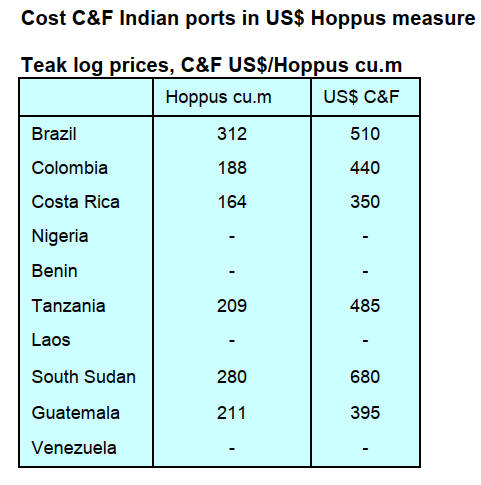
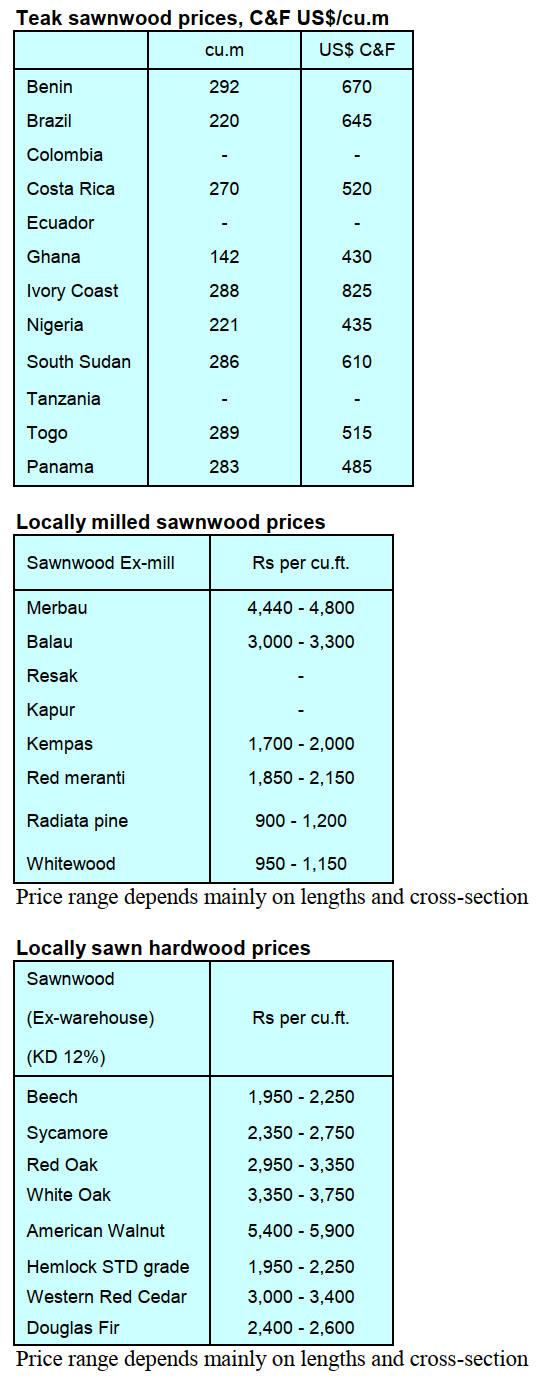
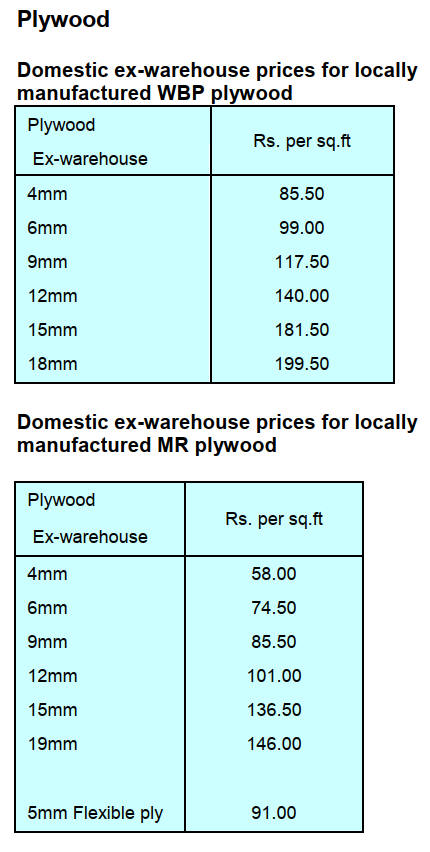
7.
VIETNAM
Wood and Wood Product (W&WP) trade highlights
Customs Department data shows W&WP exports to the
UK in August 2025 reached US$20.6 million, down 1%
compared to August 2024. In the first 8 months of 2025,
the exports of wood and wood products to the UK market
earned US$159.6 million, up 9% over the same period in
2024.
Viet Nam's W&WP exports to South Korea in August
2025 earned US$60.6 million, down 13% compared to
August 2024. In the first 8 months of 2025 W&WP
exports to this market were valued at US$493.2 million,
down 6% over the same period in 2024.
Viet Nam’s pine timber imports in August 2025 were
102,100 cu.m worth US$19.9 million, down 7% in volume
and 7% in value compared to July 2025. Compared to
August 2024, pine imports were down 9% in volume and
24% in value. In the first 8 months of 2025 pine imports
totalled 690,000 cu.m, worth US$139.5 million, up 15% in
volume and 5% in value over the same period in 2024.
This increase followed the demand for raw materials for
the wood processing industry as furniture exports continue
maintaining an upward trend.
In July 2025 imports of wood and raw materials from the
EU increased for the fourth consecutive month and
reached the highest level ever at 115,450 cu.m with a
value of US$34.73 million, up 6% in volume, but down
2% in value compared to June 2025 and an increase of 8%
in volume and 5% in value over the same period in 2024.
In the first 7 months of 2025 imports of raw wood from
the EU reached 575,860 cu.m with a value of US$183.68
million, up 24% in both volume and value over the same
period in 2024.
It is estimated that the exports of wood and wood products
in September 2025 will reach US$1.3 billion, up 4%
compared to September 2024. Of the total exports of wood
products are estimated at US$864 million, down 6%
compared to September 2024. In the first 9 months of
2025 exports of wood and wood products are estimated at
US$12.4 billion, up 6% over the same period in 2024 of
which exports of wood products are estimated at US$8.5
billion, up 5% over the same period in 2024.
In the first 9 months of 2025, the W&WP exports, in
general, maintained positive growth. However, from
August, a slowdown trend has been observed reflecting
weakness from overseas markets. This development shows
that global consumer demand is slowing down, especially
in key import markets, thereby putting pressure on the
export target of US$18 billion for the whole year 2025.
The imports of raw wood (logs and sawnwood) in
September 2025 are estimated at 684,000 cu.m, worth
US$218.9 million, up 9% in volume and 10% in value
compared to August 2025. Compared to September 2024
imports were up 39% in volume and 39% in value. In the
first 9 months of 2025 imports of raw wood are estimated
at 5.27 million cu.m, worth US$1.67 billion, up 28% in
volume and 25% in value over the same period in 2024.
In 2025 it is expected that raw wood imports to Viet Nam
will total 7 million cu.m, worth around US$2.3 billion
showing a growth momentum in the wood industry and the
trend of expanding supply from many sources to ensure
the legality and sustainability of the supply chain.
Viet Nam’s NRFP exports in August 2025 increased
slightly reaching US$66.26 million, up 0.4% compared to
July 2025 but down 1% over the same period in 2024. In
the first 8 months of 2025 NTFP exports fetched
US$574.20 million, up 5% over the same period in 2024.
Additional tariff came as a shock
From 14 October 2025 wooden furniture exported to the
US will be subject to an additional import tariff of up to
25%. This came as a shock at a time when enterprises are
accelerating production raising concerns over the
feasibility of maintaining Viet Nam’s 2025 wood export
targets.
In the long term, aside from adapting to frequently
changing tariff policies, enterprises in the wood industry
are working to improve product quality. Expanding
markets and building the Viet Namese wood brand are
considered key solutions for the sector’s sustainable
development.
The tariff rate may increase to 50% for dressing tables and
kitchen cabinets and 30% for upholstered products early
next year.
The US cited Section 232 of the 1974 Trade Act arguing
that wood and furniture imports are undermining national
security, weakening the domestic timber industry and
threatening supply chains linked to infrastructure and
defence. This decision will impact countries that export
significant volumes of wood products to the US including
Canada, Mexico and Viet Nam.
For Viet Nam the US remains the largest market for wood
products. In 2024, exports to the US were estimated at
around US$9 billion accounting for over 50% of the
industry’s total exports.
According to Ngo Si Hoai, Vice Chairman and Secretary
General of the Viet Nam Timber and Forest Products
Association, Viet Nam’s wood product exports will
certainly be affected by the decision announced by the US.
In the immediate term Viet Namese wooden furniture will
fall into the 25% tariff category. If the rate rises to 30–
50% in early 2026 many enterprises will reconsider their
strategies. Adjusting in the short term will be difficult as
the US market accounts for a significant share of Viet
Nam’s wood exports.
In fact, the US decision not only creates disadvantages for
exporting countries but has also triggerd mixed reactions
within the US itself. The higher tariffs are expected to
push up construction and production costs domestically,
while reducing the international competitiveness of the US
paper and pulp industries. Meanwhile, Viet Nam has been
a stable and reliable supplier of wood products for many
years. The new tariffs will not only affect Viet Namese
manufacturers but also have a direct impact on the entire
supply chain and American consumers.
To cope with these challenges Viet Namese wood
enterprises are strengthening supply chain cooperation,
expanding e-commerce operations, accessing new markets
and enhancing their competitiveness within global value
chains.
According to wood businesses, to respond effectively to
such tax policy fluctuations the Government should
provide greater support in terms of market information and
intelligence. It is also essential to consider tariff risk
assessment as a key tool to help enterprises develop
suitable solutions for each supply chain and product
category.
Nguyen Phuong, Vice Chairman of the Dong Nai Wood
and Handicrafts Association (Dowa), noted that in the
final months of 2025, market performance may decline
depending on the extent of tariff changes, especially since
exports to the US account for more than half of Viet
Nam’s total wood export value. Therefore, enterprises
must closely monitor market developments and trade
policies from importing countries to ensure that they have
flexible and adaptive strategies.
Another issue for the industry is fostering innovation and
breakthrough efforts in building brands in the international
market. Despite considerable improvement in recent years
Viet Nam’s furniture industry still lacks a breakthroughs
and remains largely dependent on contract manufacturing.
Businesses should vigorously pursue the goal of
establishing professional design and marketing teams to
trade under their own brands.
Sharing the same view, Nguyen Chanh Phuong, Vice
Chairman of the Handicraft and Wood Industry
Association of Ho Chi Minh City (HAWA), emphasised
the importance of production autonomy for businesses.
For sustainable development the sector requires a skilled
workforce and a legally certified source of raw materials.
At the same time the Government needs to issue
supportive policies for industry development and assist
enterprises in addressing issues arising from participation
in the global goods market.
Although market fluctuations are unavoidable they also
present opportunities for Viet Nam’s wood industry to
restructure. In recent years, thanks to its flexible market
approach, the sector has experienced strong growth. Its
annual exports reached US$16–17 billion and further
development remains within reach, particularly if brand
building continues to be prioritised.
See: https://baodongnai.com.vn/english/202510/wood-industry-
faces-new-challenges-da62da2/
Navigating tariff pressures through market
diversification
The US’s decision to impose high tariffs on a range of
Viet Namese exports, including wood products and
furniture, is pushing the country’s timber industry to
swiftly recalibrate its strategies to sustain growth.
Canada has emerged as a promising market with Viet Nam
ranking among its top three wood product suppliers.
According to the Viet Nam Timber and Forest Products
Association, Canadian buyers show strong demand for
Viet Namese products, particularly bedroom furniture,
which accounts for over 35% of the sector market share.
Analysts attribute this success to both quality and the
industry’s responsiveness to consumer preferences for
sustainable, minimalist and eco-friendly designs.
The Ministry of Industry and Trade (MoIT) has advised
businesses to prioritise Forest Stewardship Council (FSC)
certified products to meet Canadian sustainability
requirements alongside strict standards on safety,
durability and fire resistance.
The Comprehensive and Progressive Agreement for
Trans-Pacific Partnership (CPTPP) also offers tariff
advantages enhancing the competitiveness of Viet Namese
products.
Canada itself is a major timber producer with annual
output of around 600 million cubic metres, yet its furniture
industry meets only half of domestic demand. This
reliance on imports, particularly competitively priced
items, positions Viet Nam as a key supplier to bridge the
gap.
HAWA Chairman Phung Quoc Man noted that, unlike the
US, other markets have yet to impose tariffs on Viet
Namese wood. He urged enterprises to make full use of
free trade agreements, enhance design capacity and
expand online sales channels.
Nguyen Cam Trang, Deputy Director of the MoIT’s
Import-Export Department, said the ministry continues
technical talks with the US on trans-shipment issues where
clear definitions and guidelines are still lacking. In the
meantime, Viet Namese businesses are encouraged to
leverage free trade agreements and broaden export outlets
to maintain growth momentum.
See: https://Viet Namnet.vn/en/Viet Nam-s-wood-sector-
navigates-tariff-pressures-with-market-diversification-
2448006.html
8. BRAZIL
Paraná - Brazil’s second largest forestry
producer in
2024
The State of Paraná became Brazil’s second largest
forestry producer in 2024 with a record production value
of R$6.9 billion, a 27% increase compared to 2023,
according to the Brazilian Institute of Geography and
Statistics (IBGE). Paraná accounts for 16% of the national
forest production after Minas Gerais (19%) and ahead of
São Paulo (13%), together these three states account for
nearly half of the country’s total forestry output.
In 2024 platations accounted for 92% of Paraná's forest
production (R$6.34 billion), representing a 24% growth
over the previous year according to IBGE. The State is
Brazil´s the largest producer of roundwood for industrial
purposes (32%) and of fuelwood from planted forests (14
million cu.m, 26% of the national total).
Forestry production in Paraná spans 391 of the State´s 399
municipalities. The municipality of General Carneiro
ranks first nationally in plantations, with R$637.2 million
followed by Sengés, Cruz Machado, Telêmaco Borba and
Bituruna municipalities. National forest extraction
represents 8% of the state's forestry production (R$577
million), with São Mateus do Sul municipality standing
out as a key contributor. Paraná also maintains leadership
in the production of yerba mate (leaves of the plant can be
used to make a beverage known as mate) with 86% of
Brazil´s total (R$117 million) and is the largest producer
of pine nuts.
In 2024 the value of yerba mate extraction in the southern
region reached R$522.8 million, an 11% decrease
compared to 2023.
With 1.2 million hectares of planted forests Paraná ranks
as the third largest State in cultivated forest area with Pine
plantations (670,700 ha.) and maintaining a significant
share in Eucalyptus (464,440 ha.) and other species
(22,600 ha.). Timber production primarily supplies the
pulp and paper industries.
See: https://apreflorestas.com.br/noticias/com-alta-de-207-
parana-consolida-vice-lideranca-no-valor-da-producao-florestal/
Forest restoration drives investment and innovation
Forest restoration in Brazil has become a pillar of the low-
carbon economy attracting investments in projects that
combine ecological recovery, sustainable forest production
and carbon credit generation. Since 2024 companies such
as Re.green, Mombak, Symbiosis Florestal and Biomas
Carbon2Nature have joined the Brazilian Tree Industry
(Ibá) strengthening the expansion of Brazil´s forest
restoration and environmental conservation sector.
Re.green has expanded its restoration activities to over
30,000 hectares in the Amazon and Atlantic Forest biomes
with 12,000 hectares currently under active restoration in
partnership with Microsoft and Nestlé. The company
promotes the planting of millions of trees and the
generation of certified carbon credits.
Since 2021, it has cultivated 6 million seedlings in the
states of Bahia, Pará, Maranhão and Mato Grosso in
collaboration with 29 local nurseries. Mombak received
R$160 million from the Climate Fund of the Brazilian
Development Bank (BNDES) and announced an
international investment round of US$30 million,
consolidating its position as a leading company in
degraded land restoration and carbon removal through
native species reforestation in the Amazon region.
Symbiosis Florestal received R$77.6 million from the
BNDES Climate Fund in the first financing initiative
dedicated to native species silviculture in Brazil.
Supported by Apple’s Restore Fund, the project plans to
plant 3,000 hectares, with 12 native species of the Atlantic
Forest, integrating sustainable tropical wood production,
conservation and local job creation.
The Muçununga Project, a partnership between Biomes,
Carbon2Nature and Veracel Celulose, aims to restore
1,200 hectares in southern Bahia with 2 million native
timber species seedlings by 2027 removing approximately
500,000 tonmes of CO₂ over 40 years. The initiative
exemplifies a new forest business model that combines
ecological restoration, sustainable management, carbon
credit generation and biodiversity valuation marking a
significant step forward in integrating silviculture,
technological innovation and green finance in Brazil.
See: https://www.maisfloresta.com.br/restauracao-florestal-
avanca-no-brasil-e-atrai-novos-investimentos/
Brazil announces initial investment in the Tropical
Forest Fund
The Brazilian government has announced a US$1 billion
investment in the Tropical Forest Forever Facility (TFFF),
an international financial mechanism aimed at
economically valuing tropical forest conservation.
The initiative, led by Brazil with support from the World
Bank, will be officially launched during the United
Nations Climate Change Conference (COP30) in Belém,
Pará. Its initial target is to mobilise US$25 billion by
November 2025 aiming to leverage up to US$125 billion
through private sector participation.
Other potential investors include Germany, the United
Arab Emirates, France, Norway and the United Kingdom.
The TFFF proposes an annual payment model per hectare
of preserved forest, encouraging tropical countries such as
Brazil, Colombia, Ghana, Congo, Indonesia and Malaysia
to keep their forest areas standing.
In the Amazon alone investments could reach US$2
billion per year helping to reduce the current US$7 billion
annual funding gap in the region. These amounts could
triple investments in forest conservation and help to curb
the expansion of predatory development models.
See: https://agenciabrasil.ebc.com.br/meio-
ambiente/noticia/2025-09/brasil-anuncia-us-1-bilhao-para-fundo-
de-florestas-tropicais
Impact of US tariffs on the timber sector
At a public hearing at the Legislative Assembly of Paraná
the Brazilian Association of the Mechanically Processed
Wood Industry (Abimci) presented its analysis of the
“Effects and Consequences of Lack of Negotiation with
the US Government Regarding Tariffs”.
Abimci shared data and information on the impacts of US
tariff measures on the timber sector, reporting over than
4,000 layoffs have already occoured while approximately
5,500 workers are currently on forced vacation and about
1,100 on temporary layoff.
If the tariffs remain in place for another two months,
projections indicate an additional 5,000 job losses, further
increasing the economic vulnerability of the producing
regions.
Abimci emphasised that unfair competition from other
countries with lower tariffs, such as Indonesia (19%), Viet
Nam (20%) and China (35%) threatens the maintenance of
access to the US market and the client base built over the
past three decades.
This situation jeopardises the competitiveness of Brazilian
industries and may result in a permanent loss of market
share.
The Federation of Industries of Paraná (Fiep) proposed the
creation of a crisis committee to monitor the effects of the
tariffs and to develop mitigation strategies. Among the
emergency measures announced by the State government
are direct credits purchase, ICMS (Tax on the Circulation
of Merchandise and Services) relief for affected
companies, expedited credit approvals and studies on new
forms of tax reduction as well as facilitated financing
through the Southern Regional Development Bank
(BRDE).
The meeting reinforced the need for swift and coordinated
responses between the productive sector and the
government to minimise social and economic impacts,
preserve jobs and prevent factory closures, especially in
regions with a high concentration of wood industries. The
mobilisation also seeks to pressure the federal government
to resume negotiations with the US to reduce or eliminate
tariffs on Brazilian processed wood.
See: https://abimci.com.br/abimci-apresenta-impactos-da-
taxacao-dos-eua-em-audiencia-publica-na-assembleia-legislativa-
do-parana/
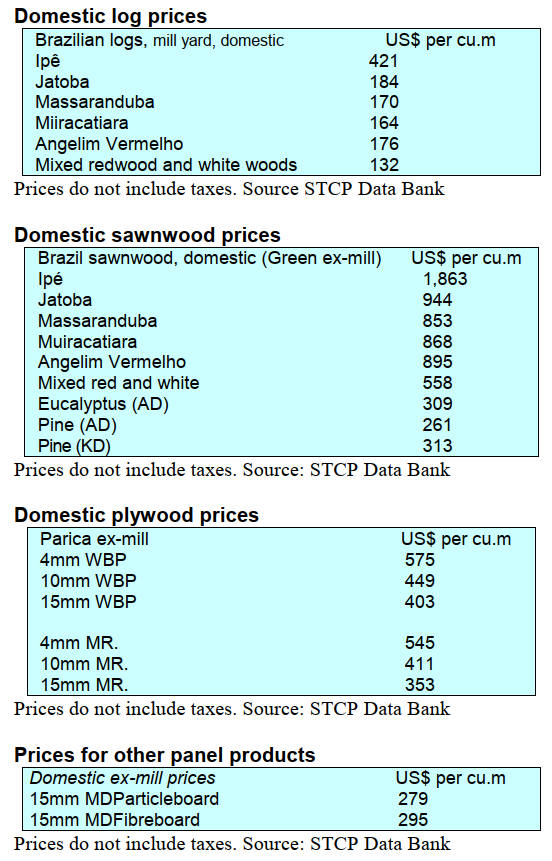
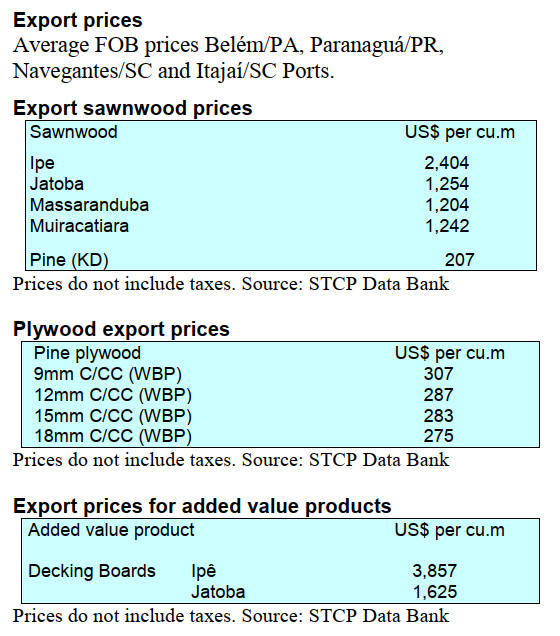
9. PERU
Pucallpa hosts business to business event
Pucallpa City was the location for the Ucayali 2025
Timber Business Roundtable, an event organised by the
Peruvian Export and Tourism Promotion Commission
(PROMPERÚ) in conjunction with the Regional
Government of Ucayali (GOREU) and the Provincial
Municipality of Coronel Portillo.
This initiative provided an opportunity for entrepreneurs in
the region's timber sector to establish direct contact with
international buyers opening new doors to the global
market and strengthening Ucayali's position as one of the
country's leading suppliers of forest products.
The event attracted the interest of foreign buyers in a
diverse variety of high-quality timber products, including
sawnwood, flooring, moldings, panels, beams, doors and
finger-jointed panels, products that represent the
productive potential of the Ucayali forestry industry.
This selection of products reflected the local timber
industry's ability to offer raw materials and value-added
products increasing the possibilities for forging
sustainable, long-term trade agreements. Representatives
of foreign companies from Chile, Colombia, Mexico,
Panama, Canada and Germany were present. For local
entrepreneurs, this business roundtable represented an
invaluable platform to showcase the quality of their
products, to establish direct business contacts and to learn
firsthand about the demands and trends in the international
market.
See:
https://eventospromperu.org.pe/event/iiiruedadenegociosdemader
a2025
Pioneering effort on Amazon forest regeneration
The Ucayali Region is advancing strategies for forest
regeneration through a study "A Look at Conservation:
Potential of Seed Trees in Native Communities and Forest
Concessions in the Ucayali Region." This research is
being conducted in the Yamino native community of the
Kakataibo people.
The project is being implemented jointly by the Forest and
Wildlife Resources Oversight Agency (OSINFOR), the
National Agrarian University of the Selva (UNAS) and the
Association for Comprehensive Research and
Development (AIDER). The institutional alliance
strengthens Amazonian forest research by examining
under-researched species and natural regeneration.
The data collected will determine the forest's natural
regeneration capacity and identify the productive potential
of seeds thus providing key information for promoting
reforestation programmes, restoring degraded areas and
developing sustainable marketing alternatives that
strengthen community economies. The species studied are
ana caspi, mashonaste, copaiba and cachimbo.
See: https://www.gob.pe/institucion/osinfor/noticias/1244472-
ucayali-impulsa-estudio-de-arboles-semilleros-para-fortalecer-la-
regeneracion-y-conservacion-de-los-bosques
CITEforestal chainsaw operator training
CITEforestal Pucallpa evaluated and certified the job
competencies of more than a dozen chainsaw operators
working for forestry companies.
The evaluation team conducted a total of 26 knowledge
tests on the job competency standards for "Cutting
Operations" and "Commercial Trunk and Log Cutting"
and the operators successfully passed both processes. The
trainees were from the companies Consorcio Maderero
S.A.C and Wood Baruch located in the Districts of
Contamana and Padre Márquez, Ucayali Province.
The role of chainsaw operators is key in the forestry
production chain as logging, carried out efficiently, safely
and responsibly, has a direct impact on the sustainability
of the resource, the legality of the timber extracted and the
productivity of companies in the sector.
See: https://www.gob.pe/institucion/citeforestal-
pucallpa/noticias/1235618-ucayali-citeforestal-pucallpa-certifico-
a-la-primera-promocion-de-operadores-de-motosierras
In related news, 195 workers from six Ucayali timber
companies were trained in occupational health and safety
during a workshop-course held at various processing
plants in Ucayali. It is noteworthy that 27 women
participated reflecting the increasingly important role of
women in a historically male-dominated industry.
See: https://cnf.org.pe/2025/09/20/curso-taller-fortalece-la-
seguridad-laboral-en-el-sector-maderero-de-pucallpa/
Latin American Forestry Congress – November 2025
The IX Latin American Forestry Congress (CONFLAT)
will take place from 19-21 November this year in the main
auditorium of UNALM, Lima, Peru, under the motto "We
all depend on the forest: let's manage Latin American
forests responsibly."
This ninth edition will address four key thematic areas: use
of natural resources in the context of climate change,
governance and economy, forestry education and
management of communal forests. It will also bring
together key stakeholders from the business sector,
authorities and public representatives, researchers,
academics and students.
CONFLAT is an initiative that originated in Peru in 1999.
Since its launch it has been a key forum for discussion and
collaboration around sustainable forest development in the
region. Countries such as Guatemala, Colombia,
Venezuela, Mexico, Brazil and Argentina have hosted this
important event.
See: https://conflat.org/home-en/
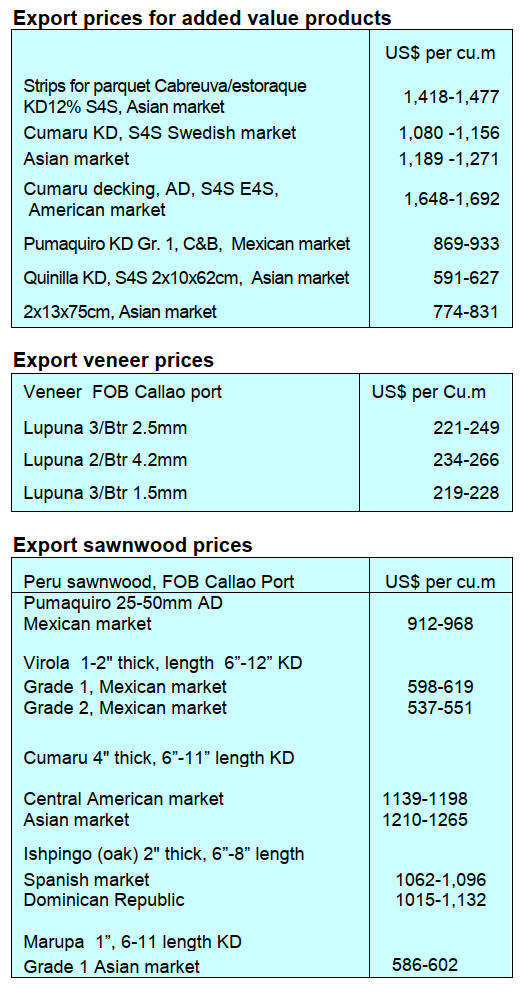
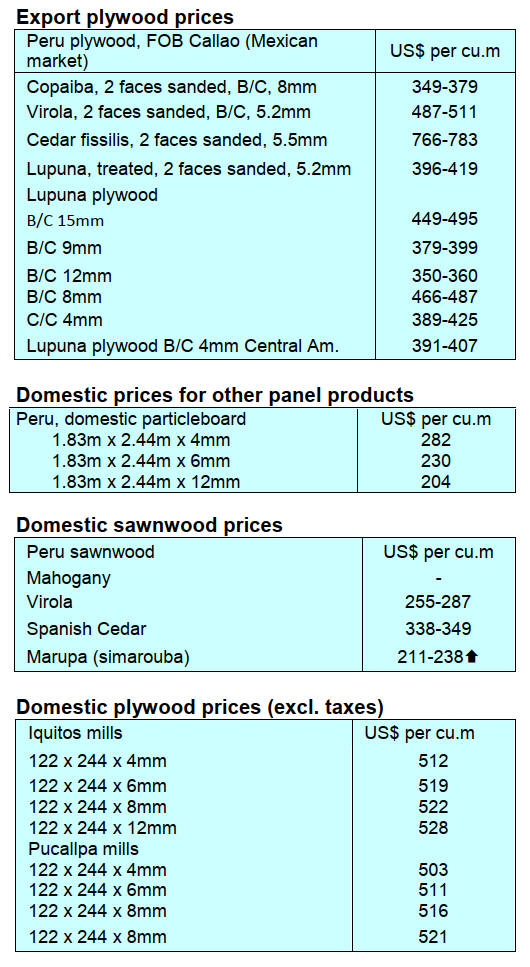
|